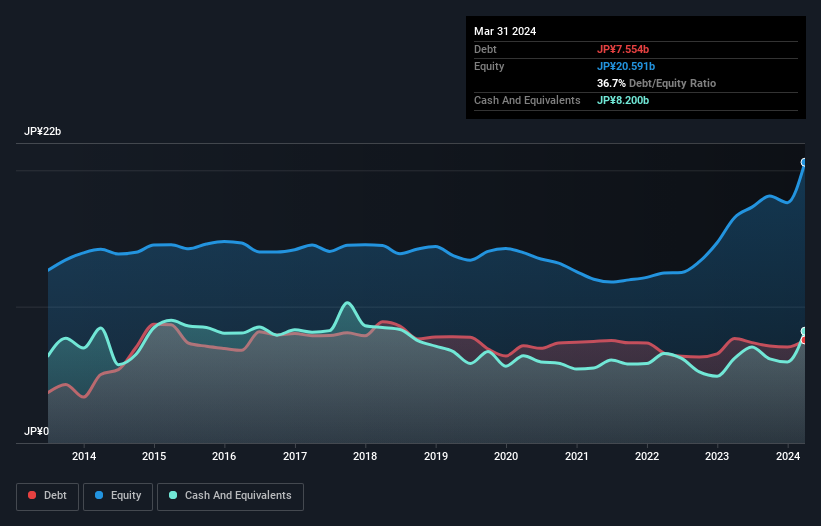Howard Marks put it nicely when he said that, rather than worrying about share price volatility, 'The possibility of permanent loss is the risk I worry about... and every practical investor I know worries about.' So it seems the smart money knows that debt - which is usually involved in bankruptcies - is a very important factor, when you assess how risky a company is. Importantly, Mamiya-OP Co., Ltd. (TSE:7991) does carry debt. But the real question is whether this debt is making the company risky.
When Is Debt Dangerous?
Generally speaking, debt only becomes a real problem when a company can't easily pay it off, either by raising capital or with its own cash flow. If things get really bad, the lenders can take control of the business. However, a more usual (but still expensive) situation is where a company must dilute shareholders at a cheap share price simply to get debt under control. By replacing dilution, though, debt can be an extremely good tool for businesses that need capital to invest in growth at high rates of return. The first thing to do when considering how much debt a business uses is to look at its cash and debt together.
See our latest analysis for Mamiya-OP
How Much Debt Does Mamiya-OP Carry?
The chart below, which you can click on for greater detail, shows that Mamiya-OP had JP¥7.55b in debt in March 2024; about the same as the year before. But on the other hand it also has JP¥8.20b in cash, leading to a JP¥646.0m net cash position.

How Strong Is Mamiya-OP's Balance Sheet?
We can see from the most recent balance sheet that Mamiya-OP had liabilities of JP¥10.9b falling due within a year, and liabilities of JP¥7.00b due beyond that. Offsetting this, it had JP¥8.20b in cash and JP¥7.32b in receivables that were due within 12 months. So its liabilities total JP¥2.36b more than the combination of its cash and short-term receivables.
Of course, Mamiya-OP has a market capitalization of JP¥12.1b, so these liabilities are probably manageable. But there are sufficient liabilities that we would certainly recommend shareholders continue to monitor the balance sheet, going forward. While it does have liabilities worth noting, Mamiya-OP also has more cash than debt, so we're pretty confident it can manage its debt safely.
Even more impressive was the fact that Mamiya-OP grew its EBIT by 157% over twelve months. If maintained that growth will make the debt even more manageable in the years ahead. When analysing debt levels, the balance sheet is the obvious place to start. But it is Mamiya-OP's earnings that will influence how the balance sheet holds up in the future. So if you're keen to discover more about its earnings, it might be worth checking out this graph of its long term earnings trend.
Finally, a company can only pay off debt with cold hard cash, not accounting profits. While Mamiya-OP has net cash on its balance sheet, it's still worth taking a look at its ability to convert earnings before interest and tax (EBIT) to free cash flow, to help us understand how quickly it is building (or eroding) that cash balance. Over the last three years, Mamiya-OP reported free cash flow worth 13% of its EBIT, which is really quite low. For us, cash conversion that low sparks a little paranoia about is ability to extinguish debt.
Summing Up
Although Mamiya-OP's balance sheet isn't particularly strong, due to the total liabilities, it is clearly positive to see that it has net cash of JP¥646.0m. And it impressed us with its EBIT growth of 157% over the last year. So we are not troubled with Mamiya-OP's debt use. The balance sheet is clearly the area to focus on when you are analysing debt. But ultimately, every company can contain risks that exist outside of the balance sheet. To that end, you should be aware of the 4 warning signs we've spotted with Mamiya-OP .
At the end of the day, it's often better to focus on companies that are free from net debt. You can access our special list of such companies (all with a track record of profit growth). It's free.
New: Manage All Your Stock Portfolios in One Place
We've created the ultimate portfolio companion for stock investors, and it's free.
• Connect an unlimited number of Portfolios and see your total in one currency
• Be alerted to new Warning Signs or Risks via email or mobile
• Track the Fair Value of your stocks
Have feedback on this article? Concerned about the content? Get in touch with us directly. Alternatively, email editorial-team (at) simplywallst.com.
This article by Simply Wall St is general in nature. We provide commentary based on historical data and analyst forecasts only using an unbiased methodology and our articles are not intended to be financial advice. It does not constitute a recommendation to buy or sell any stock, and does not take account of your objectives, or your financial situation. We aim to bring you long-term focused analysis driven by fundamental data. Note that our analysis may not factor in the latest price-sensitive company announcements or qualitative material. Simply Wall St has no position in any stocks mentioned.
About TSE:7991
Mamiya-OP
Manufactures and sells electronic and sports equipment in Japan and internationally.
Flawless balance sheet established dividend payer.
Market Insights
Community Narratives



